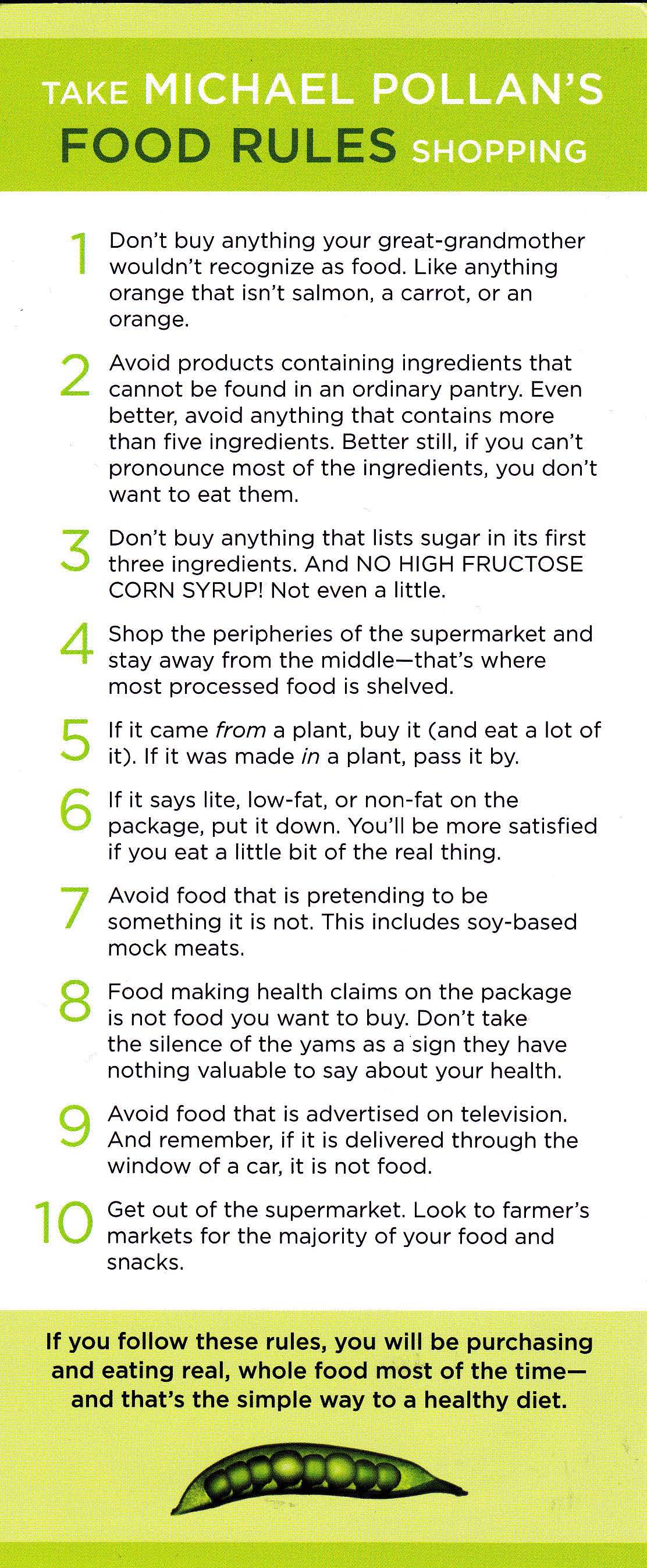Eat Food. Not Too Much. Mostly Plants.
/ Since it’s still early in 2010, I thought I’d throw my hat in the ring and share my New Year’s Resolution.
Since it’s still early in 2010, I thought I’d throw my hat in the ring and share my New Year’s Resolution.
My family and friends know that one thing I love to talk about is food.
Between my husband Dan studying to become a chef and my own studies of sustainability and the environment, the topic of food and the questions we have about it – what to eat, where to buy it, what impact it has on the planet – come up often in our family.
To us, food is a big deal. In fact (at the risk of sounding cliché), in 2009 food became a central focus for us as we defined who we wanted to be as individuals and as citizens of the earth.
Mainly this was for selfish reasons: eating food made us happy. Yet the more we learned about where our food came from, the less happy we felt.
In the early days of this conversation, I often felt more helpless than hopeful. Trips to the grocery store were spent worrying over food labels, wondering about the origins of the meat we wanted to buy, and fretting over the cost of anything labeled ‘organic’ (not to mention wondering whether organic was really all it was cracked up to be).
We often asked ourselves: how could we ever find a balance between eating food that's good for us and that we’re proud of, while also not driving ourselves nuts trying to only eat "perfect" (aka: local, seasonal, sustainable, delicious, nutritious) food?
With that, 2009 became the Year of Food Education.
Our learning started with an investigation of where our food comes from and an examination of how hard it can be to find sustainable food sources in our area. I also took a stab at defining what local food really is, and I learned about the potential dangers that exist in our current industrial food production system. Over the course of many months, we read, discussed, debated, and searched for more and more information.
In the end, all of this research proved to me and Dan that we wanted more control over what we ate and where it came from. We also wanted to know that the foods we put in our bodies were actually nutritious (and not overly processed, refined, or generally interfered with).
If you take this newfound awareness and combine it with a chef’s passion for cooking, you’ll create a kitchen that looks a lot like ours does today. Over the course of 2009, our kitchen literally went through a makeover. Slowly but surely, staples like canned soup, processed snack bars, and Ben & Jerry’s were replaced with homemade soups made with fresh stock, our very own granola bars, and even made-to-order ice cream. In fact, there’s actually very little pre-made food in our pantry and fridge at all these days. What a delicious experiment this turned out to be!
Sure, the kitchen is Dan’s favorite room in the house, so putting him to work (and motivating me to help) hasn’t been all that hard. But beyond that, our kitchen transformation is actually very reflective of the new approach we’re taking in 2010 with the food we eat.
Which brings me to my 2010 Resolution: “Eat Food. Not Too Much. Mostly Plants.”
Ok, so those aren’t my words – they actually belong to author Michael Pollan, whose book “In Defense of Food: An Eater’s Manifesto” I just finished reading. But those seven words of advice (and the entirety of his book, actually) are so perfectly aligned with the way Dan and I want to approach food in 2010 that I’ve co-opted them to use as my own.
I’m not going to write a review of this book (mainly because I think it is so full of good words of wisdom that it would mean basically re-writing the whole thing), but I can’t endorse Pollan’s ideas strongly enough. “In Defense of Food” champions the idea that eating foods (not to be confused with ingredients – for example, eating a whole food like broccoli versus an ingredient like high fructose corn syrup) is good for your health, for your spirit, for our culture, and for the environment.
To give you a little taste of Pollan’s ideas, I’ve scanned in a copy of a pamphlet I picked up in a bookstore recently. While Pollan doesn’t create a set of rules relating to what foods we should eat, he does outline some guidelines to consider when shopping for food. I’ve reprinted them here to inspire you and encourage you to think about any changes you could make in the food you buy and eat.

The thing I like best about Pollan’s ideas is that, unlike diet fad books or nutritional guidelines, “In Defense of Food” encourages us to find the pleasure, satisfaction, and joy in eating. It’s not about what you can’t or shouldn't eat; instead, it’s about embracing the history of our food and shortening the length of the chain between us and what we eat. By doing this, we'll not only feel better ourselves, but we'll feel better about our connection with the people who grow our food and with nature itself.
As I said at the beginning, Dan and I love food because eating makes us happy.
Michael Pollan's book makes it easy for us to find even more happiness through our food - and anything that can do that is a big winner for us! I hope you'll take some time to read through this book too...
And by the way - Happy New Year!

